Caroline Norma of RMIT University responded to some questions about sex work and brothel safety put to her by SafetyAtWorkBlog in response to her recently published opinion piece. This article is a companion piece to an earlier SafetyAtWorkBlog article on sex work and safety.
SAWB: What action do you recommend that brothel owners should take, beyond the current legislative and licensing requirements, to ensure that only safe sex occurs on their premises?
CN: “Brothel owners are currently commissioning violence against women by operating prostitution businesses. Prostitution is inherently a practice of violence against women, and can’t be made ‘safe’ for women by any action by pimps. In fact, brothel owners have a financial conflict of interest with regards to ensuring the safety of women in their venues, because clients will pay more for unprotected sex acts, violent sex, body punishing sex acts like anal penetration, sex with younger women, etc.” Continue reading “Academic clarifies objections to sex work”



